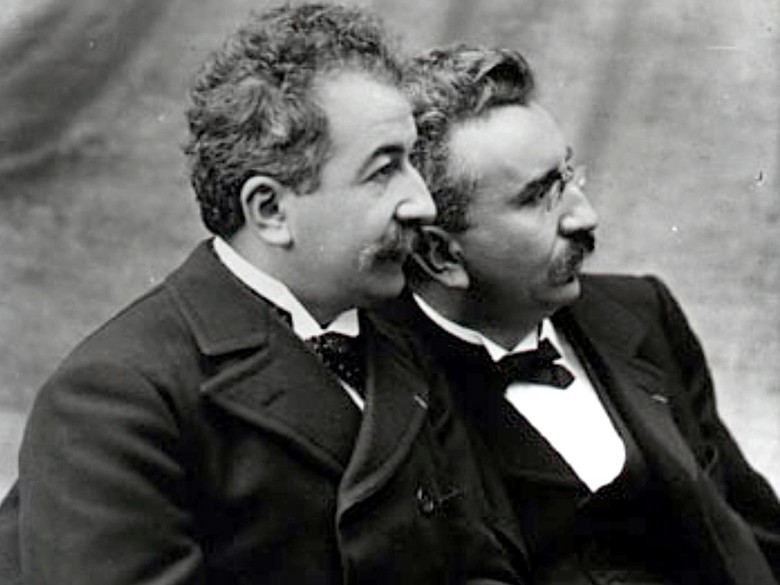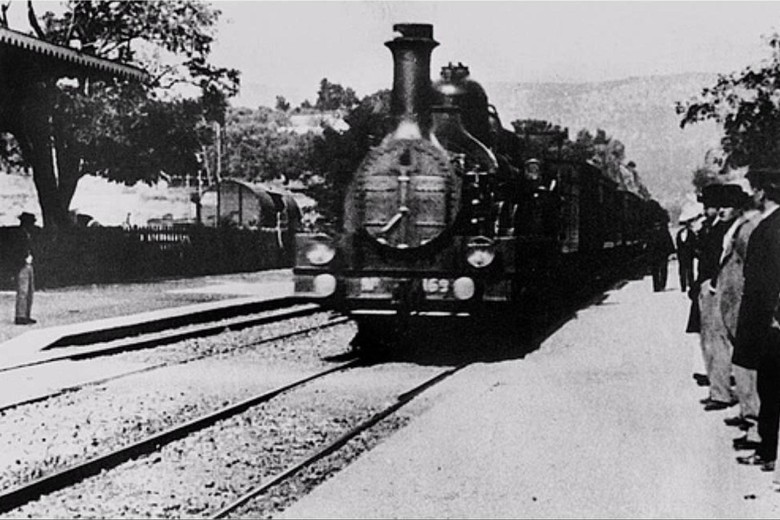Cinema and reality: how did the Lumiere brothers first erase this line?

The other day, it turned 152 years since the birth of one of the Lumiere brothers, Louis Jean Lumiere. The Lumière brothers are known as inventors of cinema and the founders of French filmmaking, but this does not end the list of their achievements. At first they made the technology of black and white photography accessible to amateurs, while only professionals could afford it, and then repeated the success with color photography.
Experiments in the field of creating moving images were carried out before the first paid film show, held in 1895. However, the Lumieres were the first to build a device that allows them not only to capture events of a little more than 50 seconds on film, but also to project the footage on the screen. The Lumières apparatus was easy and convenient, therefore the name “cinema” patented in February 1895 opened a whole era of cinema in art.
Basics of Mass Cinema

')
Kinetograph - apparatus for recording a moving image on film
Up to Lumiere, moving pictures were shown by fenakistiskop Joseph Plateau (1829), William George Horner zoootrop (1833) and Edward Meybridge zoopraxiscope (1879). Thomas Edison advanced the fastest in his work, presenting in 1889-1891 a kinetograph and a kinetoscope, devices for recording and reproducing moving images. But this technique had a big drawback - on the kinetoskop, only one person could watch the film through the eyepiece, while Louis Jean Lumiere created a device that shows movies on the big screen.

Louis developed his inventive skills while studying in an industrial school, while at the same time helping his father in the photo materials factory. In 1895, Louis invented a movie camera for shooting and projection of "moving photos", suitable for commercial use. Then he patented the device and called it "cinema". The device was an improvement of the Edison "kinetograf". The frame rate of shooting and display was 15 frames per second. At this frequency, the duration of the film that fits on a standard 35 mm film reel was 40-50 seconds.

Exit workers from the factory
Brothers Lumiera - Auguste Louis Marie Nicolas and Louis Jean began to work together. While Louis was engaged in the technical side of cinema and invention, Auguste served as an organizer and manager. And on December 28, 1895, they were able to organize in the basement of the Grand Café the first public paid session on Boulevard des Capucines in Paris. The brothers showed scenes, mostly shot on location: “Exit workers from the Lumiere Brothers Factory”, “Baby Breakfast”, “Red Fish Catching”, “Vaulting”, staging comedy sketch “Polity Sprinkler” and others.
The film library was compiled in such a way as to show all the possibilities of its “cinema”: home shooting, artistic shooting and reportage. And some films were conceived as promoters of the new technology. The Worker's Exit demonstrated the solidity of the Lumières factory, and the Delegates Leave the Hall was filmed on the eve of the show, and viewers could recognize themselves on the screen - this is how the Lumières showed the speed of the film process. The special advantage of “cinema” is shooting not in the pavilion, but on the street in daylight. The film could very quickly be prepared for viewing and show not one viewer, but the whole audience. The technology of the Lumière brothers allowed for the first time in history to record life in all its manifestations on film.
For the entrance the Lumiere brothers took one franc. Revenue from this session was 35 francs. The famous tape "Arrival of the train at the station of La Ciotat", contrary to popular belief, was not presented at the session. Her show took place in January of the same year.
In the spring of 1896, the Lumiere brothers showed their film at the Paris exhibition and were recognized as inventors of cinema. After that, they went on a world tour, visiting London, New York, Bombay, contributing to the spread of cinema throughout Europe.

" Poured irrigator " - the first in the world comedy film
Along with the advent of mass cinema, a new film language appeared. The Lumiere brothers shot a film about Venice from a smoothly moving platform (gondola). Now such a technique is called “travel”. They shot the first newsreel (“The Arrival of Delegates for Photo-Congress in Lyon”, 1895) and the first fiction film (“Watered Sprinkler”, 1895).
The rotation speed of the camera knob influenced the effect of a comedy or drama; there were various ways of installation, and in order to amuse the public, the videos were shown backwards. The first “ceremonial” plots appeared - coronations, awards, official receptions, and the technique of shooting them was not very different from modern television.
Since 1898, Louis was engaged only in the production of film equipment and film, then sold patents and continued his experiments in the field of three-dimensional and color cinema.
"Autochrome" Louis Lumiere

In 1903, Louis continued his discoveries in another area - photography. He managed to patent the method of obtaining color photography - “Autochrome”, which was used until 1935. Autochrome is the first mass production technology of color photography. Autochrome consisted of a glass plate on which a layer of varnish was applied. This layer of lacquer was covered with a layer of starch, consisting of microscopic granules, painted in red, green and blue, the space between the granules was sealed with black soot. The granules worked as color filters. Then the color layer was covered with a protective layer and a black and white emulsion.

One of the first autochromic images
In the Autochrome, the main image was black and white, and the layer of colored granules turned the black and white image into color when viewed in the light. In 1907, Louis optimizes the process and will launch the industrial production of such plates. Every day, about 6000 plates were produced, allowing even fans to make color photographs in a simple way. Louis company was one of the largest manufacturers of photographic equipment in Europe until the 60s of the twentieth century.

From the point of view of perception, the images obtained with the help of the Autochrome technology look like a synthesis of photography and painting, due to the visible starch granules. Approximation to painting is noticeable due to the static nature of the picture, due to the fact that the plate is not sensitive enough.
The arrival of the train at the station La Ciotat

One of the most famous shots in the cinema
The showing of the short film “Arrival of a train to La Ciotat” became the most enchanting in the history of the Lumiere brothers career. It took place in January 1896 and caused a furore: viewers in panic scattered to the side from the train moving from the screen. The “revived” image of the train took psychologically unprepared spectators by surprise.
The plot was mundane: a train stop appeared on the screen at the La Ciotto railway station platform and passengers walked along the cars. The effect of the "reality" of a moving train was achieved by moving in perspective, which the Lumiere brothers showed for the first time in history on a flat screen. The life-size train appeared from afar, passed obliquely from right to left through the entire screen to the fore and went beyond the left edge of the screen, creating a sense of space. One of the most important means of expression of this film was the continuous transition from the general to the medium and large plan with a fixed camera.
In this film, for the first time, filming people in general, medium and close-up was shown. The passengers who were asked to come by train were friends and relatives of the Lumiere brothers. Because of this, the film is mistakenly called the world's first production film. But he was ahead of “Watered irrigator”, the premiere of which took place 9 days earlier.
In our time, the film “The Arrival of a Train” was included in the list of “The Most Terrible Scenes of Cinema” according to the site Filmsite.org.
Cinema and virtuality
Watching the movie, we perceive events on the screen very real, but we always realize that we are participants in the perception of a work of art, and not a real event. This line was the more clearly manifested, the more rapidly the cinema developed and spread. Now it is difficult to imagine that a moving train on the screen would force us to scatter in fear, but the Lumière train made the public experience this. Then the train was perceived as real, and not “virtually”. Cinema was not massively spread and the public did not form a stable perception of the film as a different reality.
What the Lumières train was for the nineteenth-century French public is virtual reality for us. It creates a specific environment using computer graphics and allows the participant to be immersed in this environment and act in it.
Unlike the cinema, the virtual world is not aimed at the image of life, but at its free modeling. This can be represented as a series of human lives, actively using all the senses and how to respond to external stimuli. He can use the “transmigration of souls” and reincarnate into anyone. But for such a reincarnation, oddly enough, it is very important for a participant to realize his own “I”, so that there is some distance between the “I” real and the “I” virtual. Then a person gets the aesthetic experience he needs from virtual reality.
Conclusion
Probably everyone, at times, wanted to be in the atmosphere of a film, to become not only an observer of what is happening, but also an active participant. Create a suitable character for yourself, which, perhaps, would not be like a real "I".
Cinema allowed us to create and observe another reality in real time mode, immersed in its perception. Virtuality has opened before us a completely different perspective - the prospect of realizing our dreams of reincarnation and the desire to be "in another place and at another hour." With the development of technology, the degree of our immersion into this reality will continue to grow.
To the point of intersection of cinema and virtuality, we came to our own way. In honor of the 18th anniversary of the company, we are launching the Gear VR cinema in Moscow. Virtual reality is based on Samsung Gear VR technology, which allows you to watch videos in 3D format 360 degrees.
On October 15, 16 and 17, the Gear VR Cinema will be open to all comers by appointment. Sign up for a session at the links: Saturday (day of the 18th anniversary of Mail.Ru Group), Sunday , Monday .
So far this is only a non-commercial experiment designed for short user sessions. Broadcast in the cinema, we will video on their own script. What is he talking about? Surprise! Get ready for a trip to the city of the future.
Source: https://habr.com/ru/post/398331/
All Articles